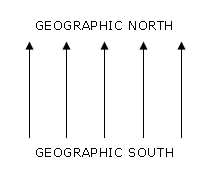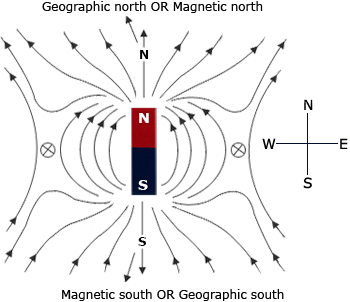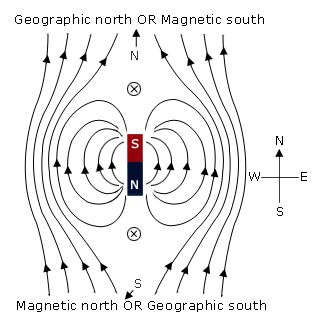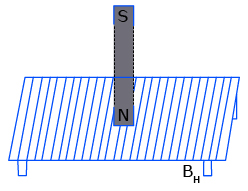Plotting of uniform magnetic field of earth:

Fix a sheet of paper on a drawing board or a table top by means of brass pins. Place a small compass needle and mark two pencil dots exactly at the two ends of the needle. Then move the compass needle in such a way that one end of the needle coincides with the second pencil dot. Mark the position of the other end of the needle with a dot. Repeat the process of moving the compass needle to obtain several dots. Join the different dots to get a straight line as shown in below figure. Thus one line of magnetic field of earth is traced.
Repeat the process from a different point and trace out another line of magnetic field . In this manner, draw several lines of magnetic field starting from the different points. Label each line with an arrow from the north pole towards the south pole of the magnet to indicate its direction. It is noticed that these lines do not cross each other. They are parallel and equi-distant.
They are directed from geographic south to geographic north (i.e., the direction in which a magnetic needle suspended freely in a horizontal plane, rests).
Plotting of non uniform magnetic field of a strong bar magnet (dipole) and neutral points:
We shall now plot the lines of non uniform magnetic field of a bar magnet placed in magnetic meridian (i.e., in geographic north-south directions) in the following two positions:
- When magnet is placed with its north pole pointing towards north.
- When magnet is placed with its south pole pointing towards north.
When magnet is placed with its north pole pointing towards north:

Fix a sheet of white paper on the drawing board with the help of brass pins. Mark north–south directions on the paper by beeping the compass needle on it. Then place a bar magnet on the paper with its north pole pointing towards north. Mark its outline with a fine pencil. Now place a small compass needle close to the iV-pole of the magnet and mark two pencil dots exactly at the two ends of the needle. Then move the compass needle in such a way that one end of the needle coincides with the second pencil dot. Mark the position of the other end of the needle with a dot. Repeat the process of moving the compass needle till the other end of the bar magnet is reached. Join the different dots to get a continuous smooth curve. Thus, one magnetic field line is traced.
Repeat the process from the same pole of the magnet but from a different point and trace out another magnetic field line. In this manner, draw several magnetic field lines starting from the different points near the same pole of the magnet. Label each line with an arrow from the north pole towards the south pole of the magnet to indicate its direction.
The magnetic field lines obtained are shown in above figure which are due to the combined effect of the magnetic field of the magnet and the earth's magnetic field.
From above figure, it is noted that:
- The magnetic field lines in the vicinity of a magnet are mainly due to the magnetic field of the magnet which is stronger than the magnetic field of the earth. As the distance from the magnet increases, the magnetic field due to the magnet decreases and at distant points it becomes weaker than the earth's magnetic field. The magnetic field lines at distant points are therefore parallel lines due to the earth's magnetic field.
- There are two points equi-distant from the centre of the magnet marked as x in above figure in the east and west directions where the magnetic field of the magnet and the horizontal component of the earth's magnetic field are equal and are in opposite directions such that they neutralize each other. These are the neutral points. A compass needle when placed at these points remains unaffected and rests in any direction.
When magnet is placed with its south pole pointing towards north:

In this case the bar magnet is placed on the paper with its south pole pointing towards north and lines of magnetic field arc traced following the method described above. The figure shows the magnetic field lines due to the combined effect of the magnetic field of the magnet and the earth's magnetic field.
- The magnetic field lines in the vicinity of the magnet arc mainly due to the magnetic field of the magnet which is much stronger than the earth's magnetic field. As the distance from the magnet increases, the magnetic field due to the magnet decreases and at distant points, it becomes weaker than the earth's magnetic field. The magnetic field at the distant points from the magnet are mainly due to the earth's magnetic field, and' therefore they are nearly parallel straight lines from south to north.
- There are two points equidistant from the centre of the magnet (marked as x) in the north and south directions where the magnetic field of the magnet and the horizontal component of the earth's magnetic field are equal and are in opposite directions such that they neutralize each other. At these points, the compass needle remains unaffected and comes to rest pointing in any direction. These points are the neutral points.
Plotting of uniform magnetic field of earth:

If a very long magnet is placed vertically with its one pole on a horizontal wooden table (or) when an isolated magnetic pole is kept in the earth's magnetic field, then
- A single neutral point will be formed in the combined field on the horizontal table.
- If 'm' is the pole strength and 'd' is the distance from the pole of the magnet where the neutral point is formed, then

- If the north pole is on the table, then the neutral point is formed towards geographic south side of the pole.
- If the south pole is on the table, then the neutral point is formed towards geographic north side of the pole.